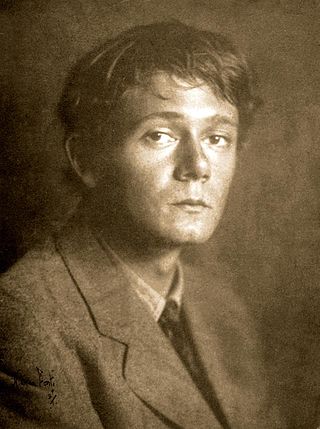
Clark Ashton Smith was an American writer and artist. He achieved early local recognition, largely through the enthusiasm of George Sterling, for traditional verse in the vein of Swinburne. As a poet, Smith is grouped with the West Coast Romantics alongside Joaquin Miller, Sterling, and Nora May French and remembered as "The Last of the Great Romantics" and "The Bard of Auburn". Smith's work was praised by his contemporaries. H. P. Lovecraft stated that "in sheer daemonic strangeness and fertility of conception, Clark Ashton Smith is perhaps unexcelled", and Ray Bradbury said that Smith "filled my mind with incredible worlds, impossibly beautiful cities, and still more fantastic creatures".
Arkham House was an American publishing house specializing in weird fiction. It was founded in Sauk City, Wisconsin, in 1939 by August Derleth and Donald Wandrei to publish hardcover collections of H. P. Lovecraft's best works, which had previously been published only in pulp magazines. The company's name is derived from Lovecraft's fictional New England city, Arkham, Massachusetts. Arkham House editions are noted for the quality of their printing and binding. The colophon for Arkham House was designed by Frank Utpatel.

Weird Tales is an American fantasy and horror fiction pulp magazine founded by J. C. Henneberger and J. M. Lansinger in late 1922. The first issue, dated March 1923, appeared on newsstands February 18. The first editor, Edwin Baird, printed early work by H. P. Lovecraft, Seabury Quinn, and Clark Ashton Smith, all of whom went on to be popular writers, but within a year, the magazine was in financial trouble. Henneberger sold his interest in the publisher, Rural Publishing Corporation, to Lansinger, and refinanced Weird Tales, with Farnsworth Wright as the new editor. The first issue to list Wright as editor was dated November 1924. The magazine was more successful under Wright, and despite occasional financial setbacks, it prospered over the next 15 years. Under Wright's control, the magazine lived up to its subtitle, "The Unique Magazine", and published a wide range of unusual fiction.

Tsathoggua is a supernatural entity in the Cthulhu Mythos shared fictional universe. He is the creation of American writer Clark Ashton Smith and is part of his Hyperborean cycle.

Averoigne is a fictional counterpart of a historical province in France, detailed in a series of short stories by the American writer Clark Ashton Smith. Smith may have based Averoigne on the actual province of Auvergne, but its name was probably influenced by the French department of Aveyron, immediately south of Auvergne, due to the similarity in pronunciation. Sixteen of Smith's stories take place in Averoigne. In Smith's fiction, the Southern French province is considered "the most witch-ridden in the entire country." The most well-known citizen is Gaspard du Nord of Vyones, a wizard who translated The Book of Eibon into Norman French.
The Hyperborean cycle is a series of short stories by Clark Ashton Smith that take place in the fictional prehistoric setting of Hyperborea. Smith's cycle takes cues from his friends, H. P. Lovecraft and Robert E. Howard and their works.
Farnsworth Wright was the editor of the pulp magazine Weird Tales during the magazine's heyday, editing 179 issues from November 1924 to March 1940. Jack Williamson called Wright "the first great fantasy editor".

"The Tale of Satampra Zeiros" is a short story written in 1929 by American author Clark Ashton Smith as part of his Hyperborean cycle, and first published in the November 1931 issue of Weird Tales. It is the story in which Smith created the Cthulhu Mythos entity Tsathoggua.

Out of Space and Time is a collection of fantasy, horror and science fiction short stories by American writer Clark Ashton Smith. It was released in 1942 and was the third book published by Arkham House. 1,054 copies were printed. A British hardcover appeared from Neville Spearman in 1971, with a two-volume paperback reprint following from Panther Books in 1974. Bison Books issued a trade paperback edition in 2006.
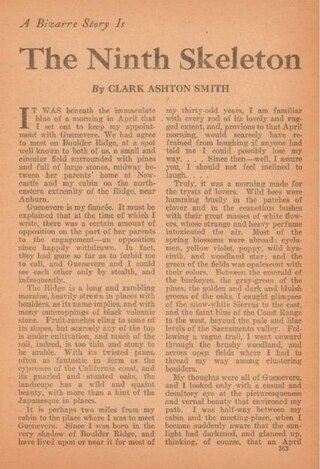
"The Ninth Skeleton" is a short story by American writer Clark Ashton Smith. It was first published in the September 1928 issue of Weird Tales. It was his first story for Weird Tales.
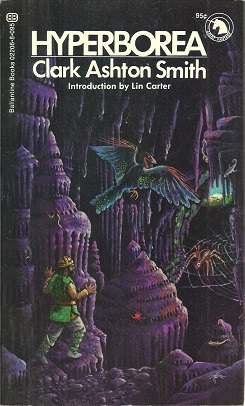
Hyperborea is a collection of fantasy short stories by Clark Ashton Smith, edited by Lin Carter. It was first published in paperback by Ballantine Books as the twenty-ninth volume of its Ballantine Adult Fantasy series in April 1971. It was the second themed collection of Smith's works assembled by Carter for the series. The stories were originally published in various fantasy magazines from the 1930s to the 1950s, notably Weird Tales.

"The Dark Eidolon" is a sword and sorcery short story by American writer Clark Ashton Smith, forming part of his Zothique cycle of stories. It was first published in Weird Tales in 1935 and has been variously republished, notably in the anthology The Spell of Seven, edited by L. Sprague de Camp.
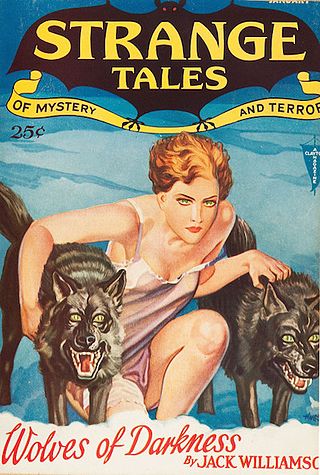
Strange Tales was an American pulp magazine first published from 1931 to 1933 by Clayton Publications. It specialized in fantasy and weird fiction, and was a significant competitor to Weird Tales, the leading magazine in the field. Its published stories include "Wolves of Darkness" by Jack Williamson, as well as work by Robert E. Howard and Clark Ashton Smith. The magazine ceased publication when Clayton entered bankruptcy. It was temporarily revived by Wildside Press, which published three issues edited by Robert M. Price from 2003 to 2007.

"Xeethra" is a short story by American author Clark Ashton Smith as part of his Zothique cycle, and first published in the December 1934 issue of Weird Tales.

"The Empire of the Necromancers" is a short story by American author Clark Ashton Smith as part of his Zothique cycle, and first published in the September 1932 issue of Weird Tales.

"The Death of Ilalotha" is a short story by American author Clark Ashton Smith as part of his Zothique cycle, and first published in the September 1937 issue of Weird Tales.

"The Charnel God" is a short story by American author Clark Ashton Smith as part of his Zothique cycle, and first published in the March 1934 issue of Weird Tales.
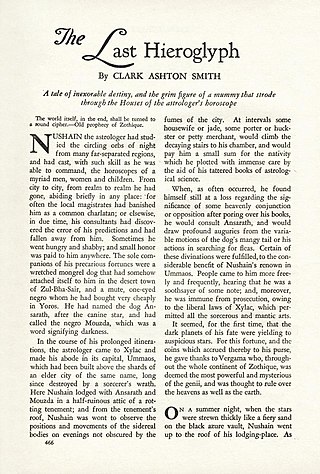
"The Last Hieroglyph " is a short story by American author Clark Ashton Smith as part of his Zothique cycle, and first published in the April 1935 issue of Weird Tales.

"The Isle of the Torturers" is a short story by American author Clark Ashton Smith as part of his Zothique cycle, and first published in the March 1933 issue of Weird Tales.

"The Voyage of King Euvoran" is a short story by American author Clark Ashton Smith as part of his Zothique cycle. It was first published as "The Voyage of King Euvoran" in the 1933 book The Double Shadow and Other Fantasies. It was republished as "Quest of the Gazolba" in the September 1947 issue of Weird Tales where it was the cover story with art by Boris Dolgov.

















